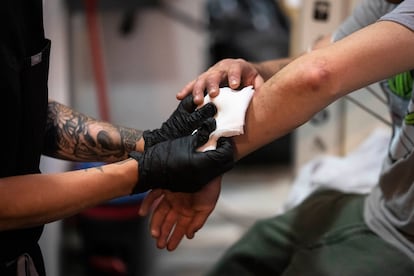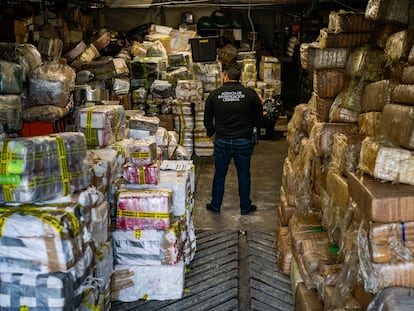The White House declares war on xylazine, the ‘zombie drug’ linked to spike in fentanyl overdoses
Known on the streets as tranq, it is an animal sedative that causes severe skin wounds. Dealers mix it with the opiate to make it cheaper and to prolong its effects


One of the drugs taking a toll on the United States is an animal anesthetic called xylazine. On Tuesday, the U.S. government launched a National Response Plan to deal with the serious effects of the drug, which can be fatal when combined with fentanyl, a powerful opioid that is responsible for two-thirds of the estimated 110,000 overdose deaths recorded in 2022. Back in April, Rahul Gupta, the director of the White House Office of National Drug Control Policy (ONDCP), warned that xylazine-laced fentanyl was an “emerging threat” to the public health of Americans.
Xylazine — which is known on the streets as tranq or the “zombie drug” — is the active ingredient in a veterinary drug, XylaMed. In 1972, the U.S. Food and Drug Administration (FDA) approved XylaMed as an analgesic and sedative for animals, but is not recommended for humans. Laboratory identifications of xylazine rose across the country between 2020 and 2021, while xylazine-positive overdose deaths increased by 1,127% in the south. Since it was announced as an emerging threat in April, the drug has been detected in nearly every part of the United States, according to Gupta.
“If we thought fentanyl was dangerous, fentanyl combined with xylazine is even deadlier,” Gupta said. According to the Centers for Disease Control and Prevention (CDC), the sedative was linked to 11% of overdose deaths last year.
On Tuesday, the administration of U.S. President Joe Biden revealed a plan to reduce overdose deaths, which reached a record high in 2022. The plan — which does not include measures to tighten the sale of the drug for veterinary uses — sets out six pillars: testing, data collection, evidence-based prevention and harm reduction, supply reduction, scheduling and research. For Gupta, who asked Congress for more funding to address the scourge, it is key to understand its real reach on the streets.
Drug dealers mix fentanyl with xylazine to increase profit, as it allows them to reduce the amount of fentanyl used in a mixture. Xylazine also produces a longer high. The side effects of xylazine alone are serious, and include skin ulcers, wounds, and necrosis. In the worst-case scenario, they can lead to amputations. The drug can also cause respiratory arrest.
As xylazine is not an opioid, it also complicates treatments aimed at reversing fentanyl overdoses. For example, the drug Narcan, whose active principle is naloxone, is highly effective in reversing overdoses, but it loses its effects when the “zombie drug” enters the equation. In March, the FDA approved the over- the-counter sale of naloxone to widen access to the life-saving drugs.
The plan announced on Tuesday also includes educating health professionals on how to treat xylazine withdrawal and addiction, as well as the skin injuries it causes; tackling illegal imports from China and Mexico and finding alternatives to naloxone that work with xylazine.
The White House has set the goal of reducing xylazine-related deaths by 15% by 2025. Over the next 60 days, a group of federal agencies will provide more details about how they aim to reach this goal.
The roots of the fentanyl crisis in the U.S. date back to the 1990s, when pharmaceutical companies such as Purdue flooded the market with painkillers called Oxycontin that they aggressively marketed. When doctors stopped prescribing the pills, the now-addicted patients turned to heroin. Fentanyl, a drug invented in the 1960s that revolutionized anesthesiology, entered the scene around the middle of the last decade.
The use of fentanyl was triggered by the pandemic. In 2020, overdose deaths grew by 20%, to 91,799 cases. In 2021, that figure rose 16% to 106,699, according to the National Institute of Drug Abuse. The following year, there were more than 110,000 overdose deaths.
The issue has also become another source of conflict between Democrats and Republicans. The most far-right wing of the GOP has called on Biden to attack fentanyl labs and traffickers in Mexico — with or without the permission of the Mexican government — in the same way that the U.S. fought the Islamic State.
Biden, who is running again for president in 2024, has put the fight against synthetic drugs at the top of his list of priorities. He needs to appear to have a solution to the opioid crisis, as he tried to show with Tuesday’s plan and Secretary of State Antony Blinken’s convening of ministers from 84 countries last Friday to launch a global alliance to address the problem.
Sign up for our weekly newsletter to get more English-language news coverage from EL PAÍS USA Edition
Tu suscripción se está usando en otro dispositivo
¿Quieres añadir otro usuario a tu suscripción?
Si continúas leyendo en este dispositivo, no se podrá leer en el otro.
FlechaTu suscripción se está usando en otro dispositivo y solo puedes acceder a EL PAÍS desde un dispositivo a la vez.
Si quieres compartir tu cuenta, cambia tu suscripción a la modalidad Premium, así podrás añadir otro usuario. Cada uno accederá con su propia cuenta de email, lo que os permitirá personalizar vuestra experiencia en EL PAÍS.
¿Tienes una suscripción de empresa? Accede aquí para contratar más cuentas.
En el caso de no saber quién está usando tu cuenta, te recomendamos cambiar tu contraseña aquí.
Si decides continuar compartiendo tu cuenta, este mensaje se mostrará en tu dispositivo y en el de la otra persona que está usando tu cuenta de forma indefinida, afectando a tu experiencia de lectura. Puedes consultar aquí los términos y condiciones de la suscripción digital.
More information
Archived In
Últimas noticias
Welcome to the post-religion era: The idea of Christianity as the absolute truth has become obsolete
‘I thought you would like it’: The risky sexual practice popularized by TV shows and TikTok
The digitalization of tourism: ‘They promise experiences and gave us the worst possible one’
Mexican peso defies uncertainty with forecasts of a new period of stability in 2026
Most viewed
- Sinaloa Cartel war is taking its toll on Los Chapitos
- Oona Chaplin: ‘I told James Cameron that I was living in a treehouse and starting a permaculture project with a friend’
- Reinhard Genzel, Nobel laureate in physics: ‘One-minute videos will never give you the truth’
- Why the price of coffee has skyrocketed: from Brazilian plantations to specialty coffee houses
- Silver prices are going crazy: This is what’s fueling the rally










































